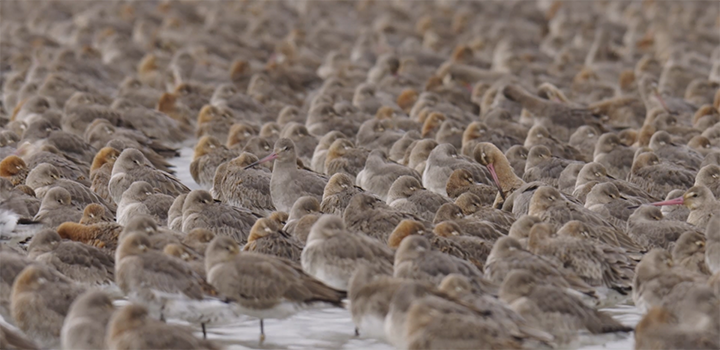Environmental impact reports hugely underestimate consequences for wildlife
By: Communications

Environmental Impact Assessments may hugely underestimate the effect that new developments have on wildlife, according to new research from the University of East Anglia.
This is because they don’t take into account how birds and other animals move around between different sites.
A study published today shows how a new airport development planned in Portugal could affect more than 10 times the number of Black-tailed Godwits estimated in a previous Environmental Impact Assessment.
The research team have been studying these Godwits across Europe for over 30 years but they say that any species that moves around is likely to be under-represented by such reports.
Here in the UK, the environmental impact of a planned tidal barrage across the Wash estuary could similarly be much worse than predicted for wild birds and England’s largest common seal colony.
Prof Jenny Gill from UEA’s School of Biological Sciences said: “Environmental Impact Assessments are carried out when developments are planned for sites where wildlife is protected.
“But the methods used to produce these reports seldom consider how species move around between different sites. This can drastically underestimate the number of animals impacted and this is particularly relevant for species that are very mobile, like birds.”
Josh Nightingale, a PhD researcher in UEA’s School of Biological Sciences and from the University of Aveiro in Portugal, said: “We studied the Tagus Estuary in Portugal, an enormous coastal wetland where a new airport is currently planned and has already been issued an environmental license.
“This area is Portugal’s most important wetland for waterbirds, and contains areas legally protected for conservation.
“But it faces the threat of having a new international airport operating at its heart, with low-altitude flightpaths overlapping the protected area.
“Black-tailed Godwits are one of several wading birds that we see in large numbers on the Tagus.
“The new airport’s Environmental Impact Assessment estimated that under six per cent of the Godwit population will be affected by the plans.
“However, by tracking movements of individual Godwits to and from the affected area, we found that the more than 68 per cent of Godwits in the Tagus estuary would in fact be exposed to disturbance from aeroplanes.”
The research team have been studying individual Black-tailed Godwits for three decades, by fitting them with uniquely identifiable combinations of coloured leg-rings.
With the help of a network of birdwatchers across Europe, they have recorded the whereabouts of individual Godwits throughout the birds’ lives.
“Many of these Godwits spend the winter on the Tagus Estuary,” said Dr José Alves, a researcher at the University of Aveiro and visiting academic at UEA’s School of Biological Sciences.
“So we used local sightings of colour-ringed birds to calculate how many of them use sites that are projected to be affected by airplanes. We were then able to predict the airport’s impact on future Godwit movements across the whole estuary.
“This method of calculating the footprint of environmental impact could be applied to assess many other proposed developments in the UK, particularly those affecting waterbirds and coastal habitats where tracking data is available.
“Eight environmental NGOs together with Client Earth have already taken the Portuguese government to court to contest the approval of this airport development. We hope our findings will help strengthen the case by showing the magnitude of the impacts, which substantially surpass those quantified in the developer’s Environmental Impact Assessment,” he added.
Conservation beyond Boundaries: Using animal movement networks in Protected Area assessment’ Is published in the journal Animal Conservation.
Related Articles

Ultra low frequency gravitational waves detected in space
Researchers at the University of East Anglia are part of an international team that have found evidence for ultra-low-frequency gravitational waves in space.
Read more
Study of Earth's stratosphere reduces uncertainty in future climate change
New research led by the University of East Anglia (UEA) reduces uncertainty in future climate change linked to the stratosphere, with important implications for life on Earth.
Read more
Investigating the coolest climate gas youve never heard of
Researchers at the University of East Anglia have launched a new project to investigate how a climate-cooling gas is produced in agriculture.
Read more